rongsheng heavy industries made in china
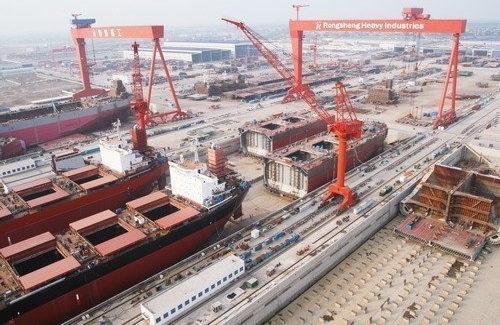
Another once-leading privately-owned yard China Huarong Energy Company, previously and better known as China Rongsheng Heavy Industries, continues to struggle with debts and ongoing talks with its creditors. The shipbuilder with huge yard facilities is now literally a �ghost yard�, where operations have ceased as funds dried up.
Jiangsu Rongsheng Heavy Industries Group Co. used to employ more than 30,000 people in the eastern city of Rugao. Once China�s largest shipbuilder, by 2015 Rongsheng was on the verge of bankruptcy. Orders had dried up and banks are refusing credit. Questions have been raised about the shipyard�s business practices, including allegations of padded order books. And Rongsheng was apparently behind on repaying some of the 20.4 billion yuan in combined debt owed to 14 banks, three trusts and three leasing firms.
Rongsheng is on the ropes now that it had completed a multi-year order for so-called Valemax ships for the Brazilian iron ore mining giant Companhia Vale do Rio Doce. The last of these 16 bulk carriers, the Ore Ningbo, was delivered in January 2015. With a carrying capacity of up to 400,000 tons, Valemaxes are the world�s largest ore carriers. Vale hired Rongsheng to build the ships starting in 2008, and has tolerated the shipyard�s slow pace: The Ore Ningbo was delivered three years late. Rongsheng employees said the Ore Ningbo may have been the shipyard�s last product because no new ship orders are expected and all contracts for unfinished ships have either been canceled or are in jeopardy.
Founder and former chairman Zhang Zhirong started the company in 2005 with money made when he worked as a property developer in the 1990s. The new shipyard stunned the industry by clinching major vessel orders from the start, even at a time when most of the world�s shipyards were slumping. Rongsheng�s success attracted investors and banks to the company�s side, fueling its expansion.
The shipyard, a sprawling facility spread across one-third of Changqingsha Island in the middle of the Yangtze River, suffered from a lack of capacity and management problems. As a result, the company had trouble meeting its contract obligations, including delivery timetables. Rongsheng�s problems were tied to difficulties with delivering ships. Many of Rongsheng�s order cancellations were due to its own delivery delays.
After the global financial crisis of 2008, many ship owners could no longer afford paying in advance for new vessels. So builders such as Rongsheng started arranging up-front financing with Chinese banks that got projects off the ground.
Rongsheng built ships with a combined capacity of 8 million tons in 2010 and was preparing to begin filling US$ 3 billion in new orders the following year. But the company�s 2011 orders wound up totaling only US$ 1.8 billion. That same year, Rongsheng�s customers canceled contracts for 23 new vessels.
In 2012, Rongsheng received orders for only two ships. Layoffs ensued, with some 20,000 workers getting the axe. The company closed the year with a net loss of 573 million yuan, down from a 1.7 billion yuan net profit in 2011 and despite 1.27 billion yuan in government subsidies. The bleeding worsened in 2013, with 8.7 billion yuan in reported losses. Despite a recovery of the Chinese shipbuilding industry in 2014, Rongsheng saw no relief, as its clients canceled orders for 59 vessels that year.
Roxen Shipping, a company controlled by Chinese businessman Guan Xiong, reportedly stepped in to rescue some US$ 2 billion worth of ship contracts that were canceled by Rongsheng�s other customers. Without these orders, Rongsheng never would have maintained its status as the No. 1 shipbuilder in China from 2009 to 2013.
Rongsheng�s capital crunch worsened since February 2014, when the China Development Bank (CDB) demanded more collateral after the company failed to make a scheduled payment on a 710 million yuan loan. When Rongsheng refused, the CDB called the loan. Other banks that issued loans to the shipbuilder had taken similar steps.
Rongsheng�s weak financial position was highlighted by a third-quarter 2014 financial report in which the company posted a net loss of 2.4 billion yuan. It also reported 31.3 billion yuan in liabilities, including 7.6 billion yuan worth of outstanding short-term debt.
It would cost at least 5 billion yuan to restart operations at Rongsheng�s facility, plus they have a huge amount of debt. Buying Rongsheng would not be a good deal.
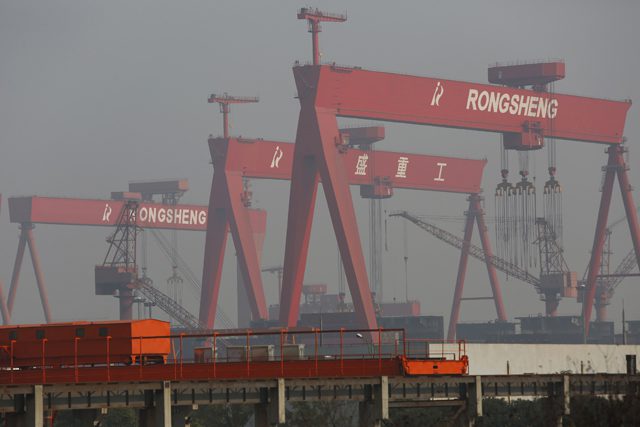
RUGAO, China/SINGAPORE (Reuters) - Deserted flats and boarded-up shops in the Yangtze river town of Changqingcun serve as a blunt reminder of the area"s reliance on China Rongsheng Heavy Industries Group, the country"s biggest private shipbuilder.A view of the Rongsheng Heavy Industries shipyard is seen in Nantong, Jiangsu province December 4, 2013. REUTERS/Aly Song
The shipbuilder this week predicted a substantial annual loss, just months after appealing to the government for financial help as it reeled from industry overcapacity and shrinking orders. Rongsheng lost an annual record 572.6 million yuan ($92 million) last year, and lost 1.3 billion yuan in the first half of this year.
While Beijing seems intent to promote a shift away from an investment-heavy model, with companies reliant on government cash injections, some analysts say Rongsheng is too big for China to let fail.
Local media reported in July that Rongsheng had laid off as many as 8,000 workers as demand slowed. Three years ago, the company had about 20,000 staff and contract employees. This week, the shipbuilder said an unspecified number of workers had been made redundant this year.
“Without new orders it’s hard to see how operations can continue,” said one worker wearing oil-spattered overalls and a Rongsheng hardhat, adding he was still waiting to be paid for September. He didn’t want to give his name as he feared he could lose his job.
“Morale in the office is quite low, since we don’t know what is the plan,” said a Rongsheng executive, who declined to be named as he is not authorized to speak to the media. “We have been getting orders but can’t seem to get construction loans from banks to build these projects.”
While Rongsheng has won just two orders this year, state-backed rival Shanghai Waigaoqiao Shipbuildinghas secured 50, according to shipbroker data. Singapore-listed Yangzijiang Shipbuildinghas won more than $1 billion in new orders and is moving into offshore jack-up rig construction, noted Jon Windham, head industrials analyst at Barclays in Hong Kong.
Frontline, a shipping company controlled by Norwegian business tycoon John Fredriksen, ordered two oil tankers from Rongsheng in 2010 for delivery earlier this year. It now expects to receive both of them in 2014, Frontline CEO Jens Martin Jensen told Reuters.
Greek shipowner DryShips Inchas also questioned whether other large tankers on order will be delivered. DryShips said Rongsheng is building 43 percent of the Suezmax vessels - tankers up to 200,000 deadweight tons - in the current global order book. That"s equivalent to 23 ships, according to Rongsheng data.
Speaking at a quarterly results briefing last month, DryShips Chief Financial Officer Ziad Nakhleh said Rongsheng was “a yard that, as we stated before, is facing difficulties and, as such, we believe there is a high probability they will not be delivered.” DryShips has four dry cargo vessels on order at the Chinese firm.
Rongsheng declined to comment on the Dryships order, citing client confidentiality. “For other orders on hand, our delivery plan is still ongoing,” a spokesman said.
At least two law firms in Shanghai and Singapore are acting for shipowners seeking compensation from Rongsheng for late or cancelled orders. “I’m now dealing with several cases against Rongsheng,” said Lawrence Chen, senior partner at law firm Wintell & Co in Shanghai.
Billionaire Zhang Zhirong, who founded Rongsheng in 2005 and is the shipyard"s biggest shareholder, last month announced plans to privatize Hong Kong-listed Glorious Property Holdingsin a HK$4.57 billion ($589.45 million) deal - a move analysts said could raise money to plug Rongsheng"s debts.
Meanwhile, Rongsheng’s shipyard woes have already pushed many people away from nearby centers, and others said they would have to go if things don’t pick up. Some said they hoped the local government might step in with financial support.
The Rugao government did not respond to requests for comment on whether it would lend financial or other support to Rongsheng. Annual reports show Rongsheng has received state subsidies in the past three years.

(Bloomberg) — China Rongsheng Heavy Industries Group Holdings Ltd., the shipbuilder whose woes made it a symbol of the country’s credit binge, said it planned to sell assets to an unidentified Chinese acquirer.
The company intends to sell the core assets and liabilities of its onshore shipbuilding and offshore engineering businesses, according to a statement to the Hong Kong exchange Monday. Rongsheng’s shares, which were halted March 11, will resume trading on March 17.
Once China’s largest shipbuilder outside government control, Shanghai-based Rongsheng has been searching for funds after orders for new ships dried up and the company fell behind on principal and interest payments on 8.57 billion yuan ($1.4 billion) of bank loans. Rongsheng’s struggles illustrate the difficulties shipbuilders face in competing with state-owned yards that have government backing and easier access to funds.
Rongsheng and the proposed buyer have entered into an exclusivity period while assets and liabilities are valued, according to the statement. The agreement will expire on June 30, the company said.
Rongsheng said March 5 it wouldn’t proceed with a proposed warrant sale after Kingwin Victory Investment Ltd. owner Wang Ping — a potential investor who had pledged as much as HK$3.2 billion ($412 million) — was said to have been detained.
Yangzijiang Shipbuilding Holdings Ltd. said previously it had been approached by China’s government about buying a stake in Rongsheng, and that no decision had been made. Yangzijiang Chief Financial Officer Liu Hua said today that the company isn’t involved in the agreement announced by Rongsheng, according to the company’s external representative.
Rongsheng has sought help from the government to benefit from a rebound in China’s shipbuilding industry — the world’s second biggest — after cutting its workforce and running up debts amid a global downturn in orders.
In September, the government responded by listing Rongsheng’s Jiangsu shipyard unit among 51 shipbuilding facilities in China deemed worthy of policy support as the industry grapples with overcapacity.
Some of Rongsheng’s subsidiaries, including Hefei Rong An Power Machinery Co. and Rongsheng Machinery Co., signed agreements with domestic lenders, led by Shanghai Pudong Development Bank, to extend debt repayments to the end of 2015, the company said in October.
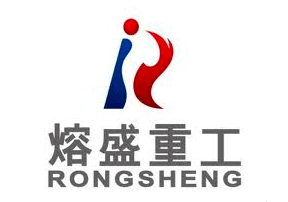
China Rongsheng Heavy Industries Group Holdings Limited (“China Rongsheng Heavy Industries” or the “Group”; stock code: 01101.HK), a large heavy industries group in China, announced that it has delivered its first 380,000 DWT Very Large Ore Carrier (VLOC) to Vale S.A. (“Vale”). The 380,000 DWT VLOC is a high-tech vessel self-developed by the Group. It is not only the world’s largest dry bulk carrier with the largest cargo capacity, but also incorporates the Group’s most advanced shipbuilding technology in very large bulk carrier. Successful delivery of the new vessel marked an innovative breakthrough for the shipbuilding industry in China.
Mr. Zhang Zhi Rong, Chairman of the Board and Non-executive Director of China Rongsheng Heavy Industries, said, “The successful delivery of the VLOC not only has extraordinary significance for the development of the shipbuilding industry in China, it also marks an important breakthrough of China Rongsheng Heavy Industries in moving towards its goal of developing into one of the world’s top diversified heavy industries group. The Group wishes to pave the way forward for private enterprises within China’s heavy industry to wield greater influence in the global market.”
Mr. Chen Qiang, Chief Executive Officer and Executive Director of China Rongsheng Heavy Industries, said, “‘VALE CHINA’ represents the most advanced bulk carrier in the world. The technologies needed for building the vessel are far more challenging than those for building the typical 200,000 DWT VLOCs. Far more advanced technologies are required to meet more demanding specifications on its structure, pressure endurance and fluid dynamic design. The delivery of the new vessel demonstrates the Group’s leadership in the global VLOC shipbuilding market.
Mr. Marcus Moura, General Manager of Shipbuilding and Conversions of Vale China, said, “‘VALE CHINA’ is professionally designed and built by China Rongsheng Heavy Industries, and is tailored to address VALE’s trade pattern and terminals requirements in Brazil. This fantastic vessel certainly will enhance our competitiveness in the iron ore market, also help our company to cope with our ambitious iron ore export plan to Asia. We would like to thank China Rongsheng Heavy Industries for its hard and dedicated work and for keeping the commitment to deliver this vessel to our fleet within the required quality standards.”
The main engine of “VALE CHINA”, the 7RT-flex 82T, is self-built by China Rongsheng Heavy Industries and produced by Hefei Rongan Power Machinery Co. Ltd., the Group’s marine engine building division. The engine has not only gained a high degree of recognition from shipowners, but is also the first Warsila low-speed diesel engine with maximum power manufactured by a Chinese enterprise independently.
The new engine boasts the advantages of huge power output, low oil consumption, compact structure, and reduced emission of SOx and NOx. All these features demonstrate the Group’s all-round shipbuilding ability while addressing the operational and environmental protection concerns of shipowners. In August 2008, the Group signed shipbuilding contracts for twelve 380,000 DWT VLOCs with Vale, having a total contract value as high as US$1.6 billion. The work under the contracts attracted wide attention at the time as it set three world records in the contract value of a single shipbuilding order, carrying deadweight tonnage of single bulk carriers and total deadweight tonnage of orders. “VALE CHINA” delivered today is the first vessel for the VLOC series. In 2009, Vale also announced that it would rent four VLOCs of the same type from Oman Shipping Company which were also to be built by China Rongsheng Heavy Industries.

Rongsheng shareholders approved for a change to the company’s name to China Huarong Energy Company, gaining approval from 99.39% of shareholders. Additionally, 98.22% of shareholders approved for the company to issue an additional 20% new shares.
Rongsheng has suspended stock trading since March 11, and a potential restructuring deal involving Yangzijiang Shipbuilding and three banks is expected to happen this week.
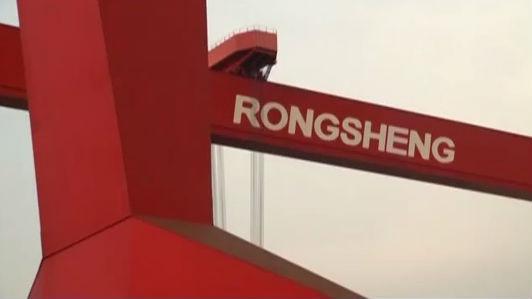
pleased to announce that, the English name of the Company has been changed from "China Rongsheng Heavy Industries Group Holdings Limited" to "China Huarong Energy Company Limited" ("Huarong Energy", the "Company" or "We", and together with its subsidiaries, the "Group"; stock code: 01101.HK) and the Chinese name of the Company has been changed
Registrar of Companies in the Cayman Islands on 18 March 2015 and the Certificate of Registration of Alteration of Name of Registered Non-Hong Kong Company was issued by the Registrar of Companies in Hong Kong on 17 April 2015. The stock short name of shares of the Company for trading on the Stock Exchange will be changed from "CH RONGSHENG" to

The two- and three-wheeler segment is getting electrified faster than cars and heavy vehicles. Auto component firms have noticed this trend and are finding ways to stay relevant.30 Dec, 2022, 10.43 AM IST
Strategists at Goldman Sachs Group Inc. expect Asia’s equity leadership to shift from Southeast Asia and India to markets like China and Korea next year, while Societe Generale SA says Taiwan’s tech-heavy market is also at an inflection point. Jefferies Financial Group Inc. has echoed similar views.27 Nov, 2022, 09.34 AM IST
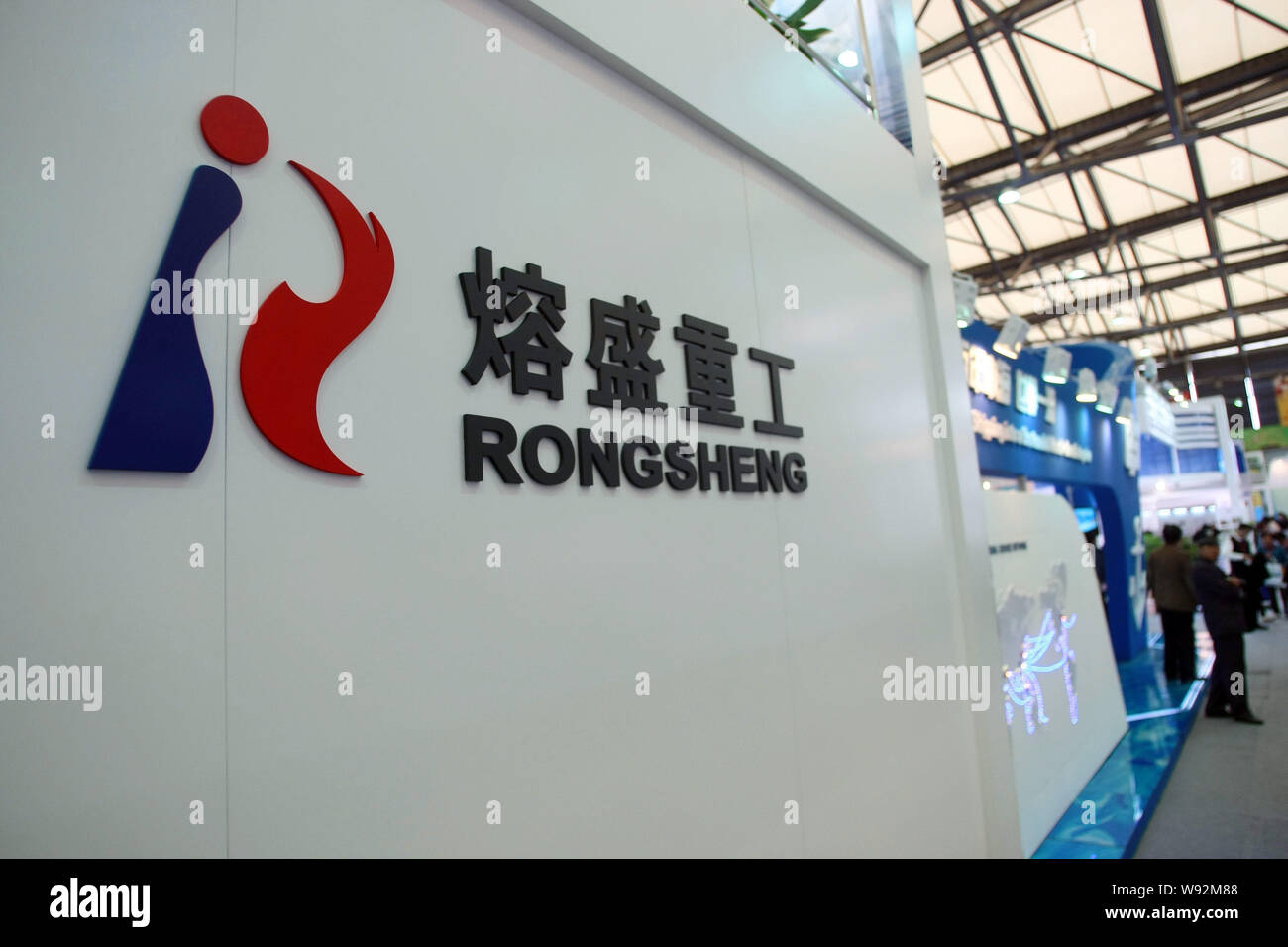
Late Tuesday, a company official told The Wall Street Journal about 8,000 employees had been laid off in recent months, and some workers had been protesting outside the company"s production base in east China"s Nantong city. Rongsheng employed about 20,000 people at the beginning of the year.
Lei Dong, secretary to Rongsheng"s president, had said that the layoffs weren"t a sign of financial trouble and were the result of a restructuring that aims to move its focus away from bulk carriers toward offshore vessels.

We have written about China Rongsheng Heavy Industries, one of the largest shipbuilders in the world, on several occasions. (See our posts from August 2012, and July 2013).
Rongsheng has been added to the growing list of Chinese companies effectively in default. With their results out for the year ending December 2013, we find it interesting that the company’s auditors, PricewaterhouseCoopers, have finally issued a report citing “multiple uncertainties relating to going concern”.
Rongsheng reported a horrendous year – revenue was down 84 per cent to RMB1.3b (US$0.2b), which produced a loss of RMB8.7b (US$1.4b). Net debt stood at RMB22.8b (US$3.66b), which compares with equity of RMB6.2b (US$1.0b). Current liabilities exceeded current assets by RMB6.68b (US$1.07b) and the company’s ten banks have extended repayment and renewal terms on its debt, known as the “debt optimisation framework agreement”.
Industry improvement is unlikely to lift Rongsheng out of its financial mess and offshore investors, whom have acquired HK$2.4b (US$0.3b) of convertible bonds in August 2013 and January 2014, will be looking closely at the security of their paper.
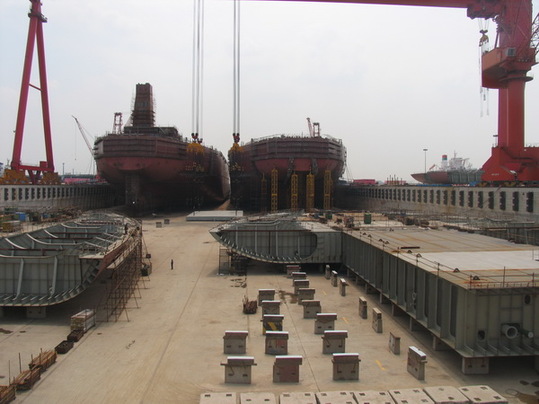
HONG KONG, Dec 4 (Reuters) - China Rongsheng Heavy Industries Group, the country"s largest private shipbuilder, said on Wednesday it expects to report a substantial full-year loss just months after it appealed to the government for financial help.
"The company believes that the net loss is primarily attributable to the decrease in revenue as a result of the company"s conservative sales strategy under the current trough stage of the shipbuilding market," China Rongsheng said in a statement to the Hong Kong stock exchange.
Greek ship owner Dryships Inc has already questioned whether some of the ships on order at China Rongsheng will be delivered, which could hit its revenue and profitability next year.
Dryships has four dry bulk carriers on order at the company"s shipbuilding subsidiary, Jiangsu Rongsheng Heavy Industries, that are due for delivery in 2014.
China Rongsheng, which sought financial help from the government in July, has said it won only two shipbuilding orders worth $55.6 million last year when its target was $1.8 billion worth of contracts.

The No 4 dock at Jiangsu Rongsheng Heavy Industries Co Ltd"s Nantong shipbuilding base on May 26, 2012. With a dimension of 139.5*580m,the dock is equipped with a 1600-T gantry crane, the world"s largest. [Photo/chinadaily.com.cn]
China Rongsheng Heavy Industries Group Holdings Ltd, the nation"s largest private shipbuilder, may seek "cooperation with one or two ship builders" in 2013 or 2014, grasping the opportunity emerging from an industry recession, according to Xu Yifei, assistant president of Jiangsu Rongsheng.
In response to this round of recession, Rongsheng has been actively upgrading technology and design. It has also put more focus on the offshore engineering sector to further diversify its business.
Rongsheng is setting up its offshore engineering company in Singapore, aiming to take advantage of Singapore"s technology and existing market to deepen its penetration in the global offshore engineering market, according to Xu.
The company entered the marine engineering sector years ago. China"s first deepwater pipe-laying crane vessel, known as Hai Yang Shi You 201, was built by Rongsheng. The vessel can lay pipes at depths of 3000 meters and lift 4000 metric tons and will operate at the South China Sea"s Liwan 3-1 gas field.
Rongsheng"s president, Chen Qiang, said in an earlier interview that he hoped orders from marine engineering will make up about 40 percent of the company"s new orders this year.




 8613371530291
8613371530291